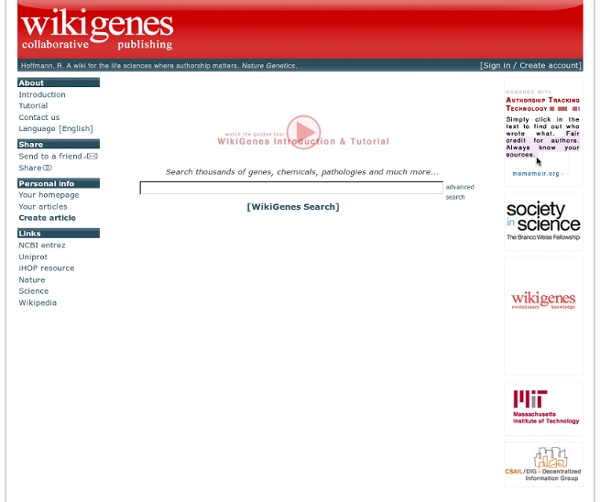



TCGA Home - TCGA TCGA is a large project composed of multiple components and equipped with various custom applications to handle large volumes of research data. The following items will familiarize you with many facets of the project and inform you of TCGA news of interest Before you begin... About TCGA - Learn about the history and goals of TCGA.Data Primer - Read the data primer to get an overview of the project goals, background, organization and data resources.Publication Guidelines - This documents provides guidelines surrounding use of TCGA data for publications and research.Mailing lists - Subscribe to mailing lists to receive updates on data availability and TCGA news.News and upcoming events - Watch for news and upcoming events that affect the TCGA community. If you need help... If you submit data... Accessing data... Retrieving Data from the TCGA Data Portal
Connecting the Dots between PubMed Abstracts Background There are now a multitude of articles published in a diversity of journals providing information about genes, proteins, pathways, and diseases. Each article investigates subsets of a biological process, but to gain insight into the functioning of a system as a whole, we must integrate information from multiple publications. Particularly, unraveling relationships between extra-cellular inputs and downstream molecular response mechanisms requires integrating conclusions from diverse publications. Methodology We present an automated approach to biological knowledge discovery from PubMed abstracts, suitable for “connecting the dots” across the literature. Conclusions Figures Citation: Hossain MS, Gresock J, Edmonds Y, Helm R, Potts M, et al. (2012) Connecting the Dots between PubMed Abstracts. Editor: Christos A. Received: July 26, 2011; Accepted: November 29, 2011; Published: January 3, 2012 Copyright: © 2012 Hossain et al. Introduction Example Story K.N. E. L. J.W. C.
Full text | Text-mining of PubMed abstracts by natural language processing to create a public knowledge base on molecular mechanisms of bacterial enteropathogens Development strategy NetOwl® Extractor webcite from SRA International, a state-of-the-art information extraction (IE) engine, was used to extract entities and relations of interest to enteropathogen research. NetOwl®, originally published as REES, is well-suited to the task because it has been designed as a scalable, portable system for entity, relation, and event extraction [10]. With over 12 years of research and development, NetOwl® has a proven track record, and has demonstrated superior performance in various benchmarking events such as the Automated Content Extraction Evaluation sponsored by the National Institute of Standards and Technology [11]. NetOwl® Extractor typically extracts relations between two entities. The first step in development was to select concepts of interest for automated extraction. The second step was to choose the type of documents as input for the system. Additional file 1. Format: TXT Size: 3KB Download file Table 1.
Entrez Programming Utilities Help - NCBI Bookshelf FactorBook DAS registration - server Ali Baba — PubMed as a graph prefuse | interactive information visualization toolkit Molecular analysis of glioblastoma:... [Cancer Biol Ther. 2003 May-Jun